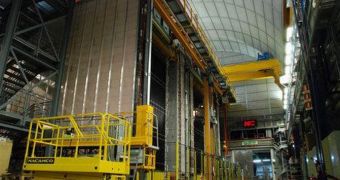A group of investigators in Italy announced yesterday, May 31, that they were able to identify tau particles sent through the ground for the first time ever. The elementary particles were encased in a muon neutrino beam, which was sent from a CERN (European Organization for Nuclear Research) facility some 730 kilometers away. The particle was detected using the OPERA experiment, which is located at the Gran Sasso laboratory. The facility is operated by the Italian National Institute of Nuclear Physics (INFN), ScienceDaily reports.
With the success of this operation, physicists finally find the final piece of a 50-year-old scientific puzzle, and they say that a new dawn for physics is at hand. The reason why the scientific community was baffled by muon neutrinos is the fact that experiments showed that a lot less of the particles came in from the Sun than expected. This could have happened for two reasons – either the solar models were wrong, which was highly unlikely, or something was happening to the neutrinos as they were passing through our planet. Back in 1969, theoretical physicists Bruno Pontecorvo and Vladimir Gribov first proposed the oscillation theory, which stated that the particles changed between various states.
All of this, they said, happened while the neutrinos were passing through the Earth. But validating their predictions proved hard to accomplish. This is why the new experiment is so critically-important. The discovery of a tau neutrino in a beam of pure muon neutrino particles is clear proof that something is forcing these elements to change, therefore acting as chameleons. The new conclusions are “an important result which rewards the entire OPERA collaboration for its years of commitment and which confirms that we have made sound experimental choices. We are confident that this first event will be followed by others that will fully demonstrate the appearance of neutrino oscillation,” says OPERA spokesman Antonio Ereditato.
“The OPERA experiment has reached its first goal: the detection of a tau neutrino obtained from the transformation of a muon neutrino, which occurred during the journey from Geneva to the Gran Sasso Laboratory. This important result comes after a decade of intense work performed by the Collaboration, with the support of the Laboratory, and it again confirms that LNGS is a leading laboratory in Astroparticle Physics,” adds the director Gran Sasso laboratories, Lucia Votano.
“This success is due to the tenacity and inventiveness of the physicists of the international community, who designed a particle beam especially for this experiment. In this way, the original design of Gran Sasso has been crowned with success. In fact, when constructed, the laboratories were oriented so that they could receive particle beams from CERN,” concludes Roberto Petronzio, the president of INFN. A trip from CERN to Italy takes just 2.4 milliseconds for the muon beam.

 14 DAY TRIAL //
14 DAY TRIAL //